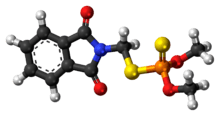Phosmet
 | |
 | |
| Names | |
|---|---|
| IUPAC name
2-(Dimethoxyphosphinothioylthiomethyl)isoindoline-1,3-dione | |
| Other names
Fosmet Decemthion Imidathion Imidan Phthalophos | |
| Identifiers | |
| 732-11-6 | |
| 3D model (Jmol) | Interactive image |
| ChEBI | CHEBI:38786 |
| ChemSpider | 12367 |
| ECHA InfoCard | 100.010.899 |
| KEGG | C18756 |
| PubChem | 12901 |
| UNII | VN04LI540Y |
| |
| |
| Properties | |
| C11H12NO4PS2 | |
| Molar mass | 317.323 |
| Appearance | White to off-white crystals |
| Density | 1.03 g/cm3 |
| Melting point | 72 °C (162 °F; 345 K) |
| Boiling point | Decomposes at >100 °C |
| Pharmacology | |
| QP53AF06 (WHO) QP53BB03 (WHO) | |
| Except where otherwise noted, data are given for materials in their standard state (at 25 °C [77 °F], 100 kPa). | |
| | |
| Infobox references | |
Phosmet is a phthalimide-derived, non-systemic, organophosphate insecticide used on plants and animals. It is mainly used on apple trees for control of codling moth, though it is also used on a wide range of fruit crops, ornamentals, and vines for the control of aphids, suckers, mites, and fruit flies.[2]
Safety
Phosmet is on the US Emergency Planning List of Extremely Hazardous Substances. It is highly toxic to bees.[2]
References
- ↑ "Phosmet Safety Card". Retrieved 2006-08-06.
- 1 2 "Toxicology of Phosmet" (Webpage). Retrieved 2006-08-06.
External links
- Phosmet in the Pesticide Properties DataBase (PPDB)
This article is issued from Wikipedia - version of the 7/29/2016. The text is available under the Creative Commons Attribution/Share Alike but additional terms may apply for the media files.